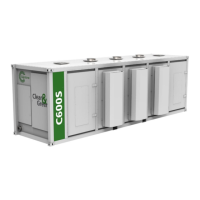Capstone Turbine Corporation • 16640 Stagg Street • Van Nuys • CA 91406 • USA
Installation Guide: Capstone C1000S/C800S/C600S with C1000 Series Controller
480064 Rev C (December 2018) Page 70 of 122
Capstone reserves the right to change or modify, without notice, the design, specifications, and/or contents of this document without
incurring any obligation either with respect to equipment previously sold or in the process of construction.
There are several reasons for this requirement:
In Grid Connect operation, the microturbine voltage reference is taken from each phase
to neutral. If the microturbine’s phase-to-neutral voltage does not match the
transformer’s phase-to-neutral voltage, the generated power may not match the actual
power into the grid. This could generate excessive or deficient levels of current out of the
microturbine, and cause nuisance under-voltage or over-voltage trips.
For Stand Alone operation, all neutrals must be tied at the same point, even if there are
no single-phase loads. Even when there are no single-phase loads, there will be current
flowing through the transformer, due to the harmonics generated by the inverters.
Therefore, this requirement is completely independent of the existence of single-phase
loads. Do not undersize neutral conductors. Inverter switching frequency can increase
the cable impedance between neutral and ground connections from each microturbine,
which in turn will yield a higher voltage differential between neutral and ground.
Individual neutrals from each microturbine grounded at the same point ensures all
microturbines are reading the same voltage reference.
7.3. Overcurrent Protection and Disconnecting Devices
Overcurrent protection is required for each microturbine, usually by circuit breaker or fused
disconnect. This overcurrent protection device must be installed between the microturbine and
the electrical bus connection. The type and fault-current ratings of the device must meet the
nameplate ratings for each microturbine model as well as meet all local codes and specifications.
Table 12 gives recommended sizing for overcurrent protection devices.
Table 12. Overcurrent Protection Sizing
If future capacity upgrades are planned for a C600 or C800 to a C1000, the larger frame size can
be used and the trip setting adjusted accordingly. If a fused disconnect switch is used instead of
circuit breaker, then fast-acting, current-limiting fuses — installed on the microturbine side of the
switch — are recommended.

